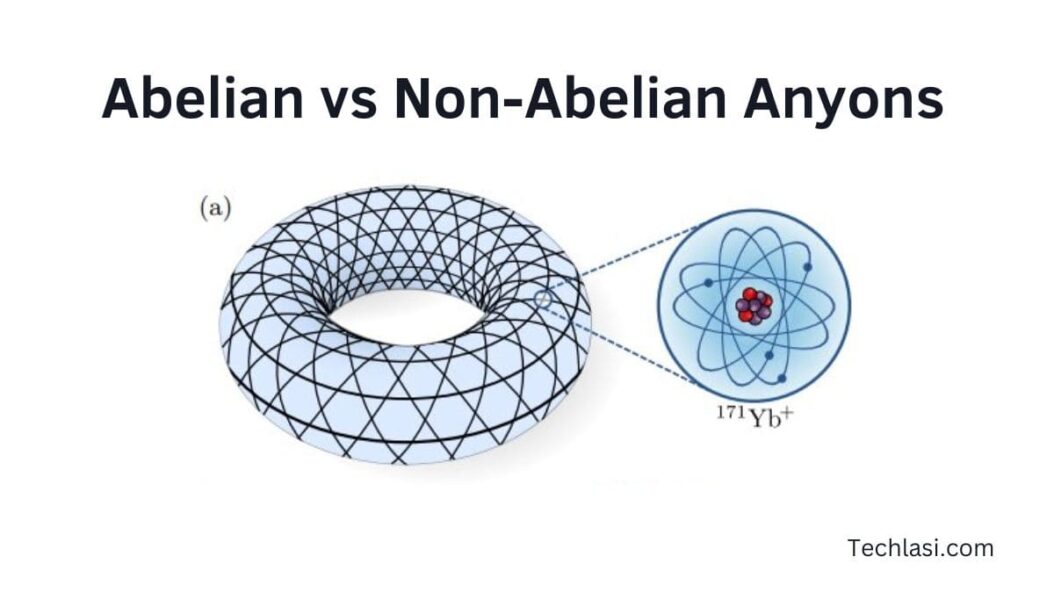What are Anyons?
Anyons are quasiparticles that occur only in two dimensional systems and have fractional statistics that are neither fermionic nor bosonic. They were first theorized in the 1980s as emergent particles in topological phases of matter like the fractional quantum Hall states.
Quantum Statistics Background
Particles come in two varieties based on their quantum spin statistics:
- Fermions like electrons have half integer spin and obey Fermi-Dirac statistics
- Bosons like photons have integer spin and obey Bose Einstein statistics
Anyons are 2D quasiparticles that can have fractional or even non-abelian statistics, unlike regular particles.
Abelian vs Non-Abelian Anyons
| Property | Abelian Anyons | Non-Abelian Anyons |
|---|---|---|
| Exchange Statistics | Commute under exchange (Abelian statistics) | Do not commute under exchange (Non-abelian statistics) |
| Braiding Operations | Braiding operations result in phase factors | Braiding operations result in non-commutative unitary transformations |
| Quantum Information | Limited for quantum computation | Potential for topologically protected quantum information storage and processing |
| Topological Quantum Gates | Limited set of topologically protected gates | Richer set of topologically protected gates |
| Examples | Anyons in the Toric Code model (e.g., Z_2 anyons) | Fibonacci anyons (e.g., in the Potts model) |
| Error Correction | Limited error correction capabilities | Potential for topologically protected error correction codes |
| Braiding Path Independence | Braiding outcome is path-independent | Braiding outcome depends on the chosen path |
| Experimental Realization | Easier to realize experimentally | Challenging to realize experimentally, but potential for fault-tolerant quantum computation |
| Fractional Quantum Hall Effect | Examples in fractional quantum Hall systems | Examples in certain topological phases of matter |
Abelian Anyons
Abelian anyons like those in fractional quantum Hall phases have commutative exchange statistics. Exchanging two abelian anyons leads to a fractional statistical phase factor e^(iθ). Here θ can take any fractional value between 0 and 2π.
Some properties of abelian anyons:
- Mutually commute under particle exchange
- Relatively simple theoretical description
- Constrained dynamics
Non-Abelian Anyons
In contrast, non-abelian anyons are very different. Exchanging two non-abelian anyons applies a non-commutative unitary operation on the multi-particle wavefunction. This leads to a much richer set of dynamics and possibilities.
Key properties of non-abelian anyons:
- Do not commute under exchange
- Very complex theoretical behavior
- Enable topological quantum computation
Emergence in Topological Phases
Non-abelian anyons can emerge as excitations in certain 2D topological ordered phases like [Ising anyons] or Fibonacci anyons. The exotic topological order protects the fractionality of the anyons. Candidate systems proposed to host them include ν = 5/2 fractional quantum Hall state, [Kitaev’s honeycomb model], p-wave paired superconductors, etc.
Why Non-Abelian Anyons are Exciting
Topological Quantum Computation
The true appeal of non-abelian anyons is their potential application for building a topological quantum computer. The non-abelian statistics encodes quantum information in a way that is naturally resistant to errors. Quantum information is stored in the combined fusion state of multiple non-abelian anyons. Braiding operations correspond to topological protected gates. Diagrammatically, exchange operations and braids of non-abelian anyons translate to robust fault-tolerant gates. No external fields are needed to control the system. This gives topological quantum computation its inherent robustness against local sources of decoherence.
Conceptual Building Blocks
Several key conceptual ingredients underlie topological quantum computation using non-abelian anyons:
- Fusion spaces as computational spaces
- F quantum numbers storing quantum data
- Braiding enacting quantum gates
- Measurement reading out quantum states
Together, they allow information processing relying solely on emergent topological properties rather than precision control of individual degrees of freedom susceptible to error.
Technological Path Forward
On the technology side, there has been remarkable progress engineering candidate non-abelian anyon platforms over the past years. Multiple experiments have now demonstrated signature properties of Ising anyons in quantum Hall systems, Majorana zero modes in nanowires, and syndrome measurements indicative of non-abelian anyons.
The current challenges are reducing disorder in quantum Hall samples to conclusively identify signatures of non-abelian anyons, further scaling up superconducting and semiconductor Majorana wire assemblies, and developing schemes for braiding operations. If these challenges are overcome in the next few years, we may be on track to perform proof of principle information processing tasks with non-abelian anyons within the next decade.
Conclusion
In summary, non-abelian anyons are exotic quasiparticles with extraordinary properties enabling inherently fault-tolerant quantum information processing. Their non-commuting exchange statistics gives rise to an elegant framework for robust topological quantum computation. Recent experimental progress combined with sophisticated theoretical modeling paints an optimistic picture for utilizing non-abelian anyons for quantum technologies in the foreseeable future. Mastering control and manipulation of these exotic particles may lead to a new paradigm in quantum computing.
FAQs
What is the key difference between abelian and non-abelian anyons?
The key difference is that exchanging two abelian anyons commutes, while exchanging non-abelian anyons leads to non-commuting operations. This gives non-abelian anyons much richer dynamics.
Where can non-abelian anyons emerge?
Non-abelian anyons can emerge as excitations in certain 2D topological ordered phases like the ν = 5/2 fractional quantum Hall state or engineered platforms like p-wave paired superconductors.
Why are non-abelian anyons useful for quantum computation?
Their exotic exchange statistics encodes and manipulates quantum information in a way that is naturally protected from errors. This enables inherent fault tolerance without requiring laborious quantum error correction.
What are the main challenges to harness non-abelian anyons experimentally?
The main challenges are conclusively identifying signature properties in experiments, further scaling up candidate platforms like topological superconductors, and developing capabilities for braiding and measurement operations.
What might a topological quantum computer based on non-abelian anyons look like?
It could be a highly stable, self-correcting quantum processor composed of engineered two-dimensional arrays of non-abelian anyon systems. Information would be written, processed, and read out by braiding and measuring anyons in this robust medium.

